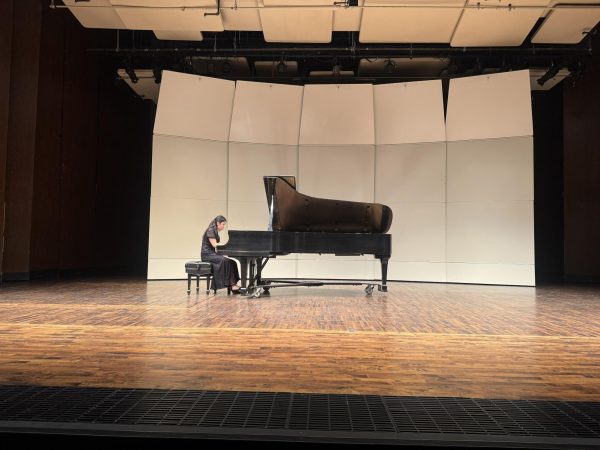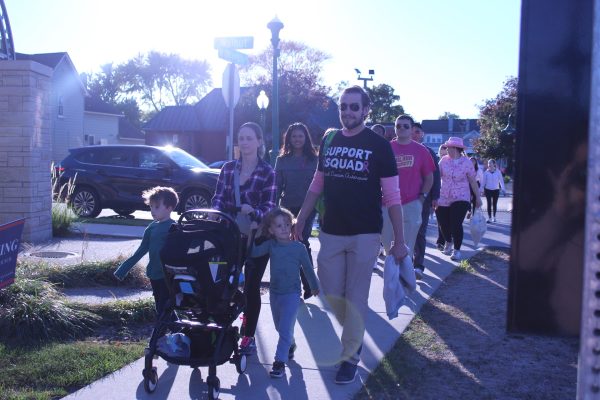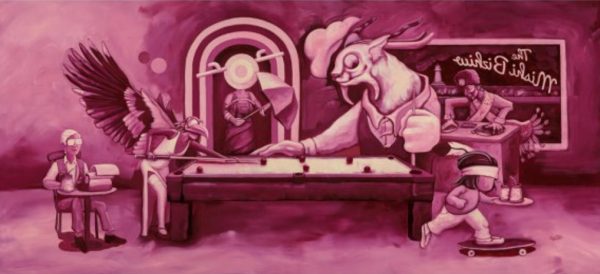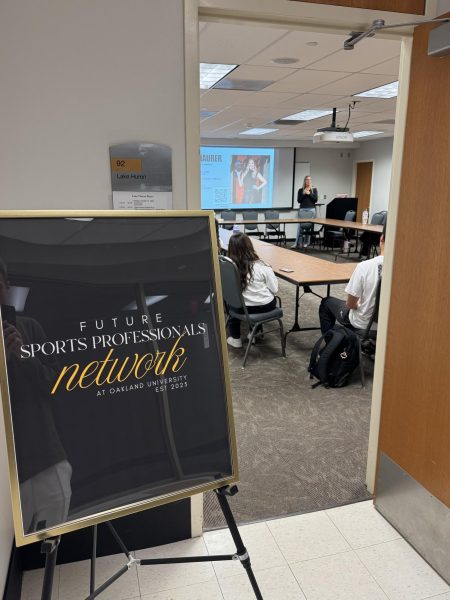State of The University Address recognizes budget shortfall and enrollment decrease, highlights areas of growth
President Ora Hirsch Pescovitz delivering the State of The University Address on Thursday, Oct. 21.
President Ora Hirsch Pescovitz addressed the Oakland University community on Thursday, Oct. 21 during the annual State of The University Address in the Oakland Center (OC) Founder’s Ballrooms. Executive Vice President for Academic Affairs and Provost Britt Rios Ellis presented on the State of Academic Affairs.
The following were discussed: (including but not limited to) the tuition shortfall, expenditures, campus construction projects, graduation rate, graduation rate for Underrepresented Minority (URM) students, COVID-19 collective vaccination status, growth, new leadership and ways to propel the university forward.
Finances
Pescovitz said approximately 80% of OU’s revenue is derived from tuition, and about 18% from state appropriation. In 1972, state funding made up 71% of revenue — a number that has decreased to 18% in 2021. According to Pescovitz, this is the lowest of Michigan’s 15 public universities, with $3,079 allocated per student and $53.4 million total.
The “Strive for 45” campaign was created pre-pandemic in an effort to increase the minimum state funding to $4,500 per student.
“The state’s disinvestment in public higher education is negatively impacting revenue at Michigan’s public universities,” Pescovitz said.
Financial aid is distributed in an amount similar to what’s recieved in state appropriation. In regard to expenses, approximately 80% go to compensation — about the same amount received in tuition revenue.
This year — with enrollment and credit hours down by 8.1% — there is a tuition shortfall of $8.6 million. OU expects an additional shortfall of $7.4 million this winter.
For this fiscal year, the university is expecting a $16 million shortfall of revenue.
“We are concerned this shortfall is not just a short term issue,” Pescovitz said.
To address the budget — OU can increase revenue, attract and attain more students, receive a higher state appropriation, increase philanthropic giving and reduce expenditures, according to Pescovitz.
Campus Construction
The currently active Wilson Hall renovation, expected to be completed by August 2022, cost $21.5 million. The South Foundation Hall renovation, which was seemingly delayed, has an expected completion date of Fall 2023 — costing the university $40 million. Varner Hall’s $45 million renovation has a projected occupancy date of Fall 2023.
“All of these projects are designed to provide our students, faculty and staff with the resources they need to be nurtured in their education, scholarship and research,” Pescovitz said.
According to Pescovitz, these projects are financed through bonds, state capital outlay funds and university reserves.
Enrollment
“To put it simply, our enrollment is down 10% over the past three years,” Rios-Ellis said.
First-Time Full-Time one year retention rates have declined by 6% — going from 79% in Fall 2019 to 73% in Fall 2020. To combat this, the university wants to enhance students’ first year experience, increase supplemental instruction and improve data use and student success assessment.
Graduation Rate Gap
There is a persistently large gap between URM students and non-URM students that appears to be increasing, according to Rios-Ellis. Since the 2008 cohort, the six-year graduation rate cap between URM and non-URM students has been between 20 and 25%.
“A commitment to equity within a higher education environment translates to renewing our promise to eliminate achievement gaps, thus reaching our shared goal of educational equity,” Rios-Ellis said.
URM students now represent 22% of OU’s incoming class. Unfortunately, 45% of URM students did not continue at OU this year, as mentioned by Rios-Ellis.
“We will collaborate with student affairs, and Senior Vice President Glenn McIntosh, to create initiatives that focus on Pell-eligible, first generation students and enhance students’ first year experience,” Rios-Ellis said. “…When we re-frame diversity as an asset, we invite ourselves to engage in positive transformation.”
Growth and Improvement since 2010
Since 2010, OU has added the School of Medicine (2011), School of Music, Theatre and Dance (2017), 23 Bachelor’s programs, increased full-time faculty from 536 to 638 faculty members, among other feats.
OU has also brought in new leadership — Elaine Carey, Ph.D, Dean of the College of Arts and Sciences, and Mohamed Al-Shabrawey, MBBCH (M.D.), M.Sc., Ph.D., Director of the Eye Research Institute.
Diversity Advocate Training has been implemented for search committee members, and OU is now working with Human Resources to engage all Faculty Affairs staff and faculty in Implicit Bias Training.
Pescovitz’s Closing Statement
To conclude the State of The University Address, Pescovitz stressed — “let the healing begin.”
“Let’s move forward together as one community,” she said. “Thank you for all your hard work and commitment to Oakland University.”









a faculty member • Nov 16, 2021 at 9:13 AM
For all the constant worry about student enrollment levels we have heard for the last year, I see no strategy from the university to deal with it. As I drive around OU’s campus I see billboards for MSU, Wayne State, UMich, and smaller colleges. How about really following the medical science on pandemic disease and making vaccines really mandated? Then advertise to Moms who want a very pandemic safe place to send their kids to college? We could easily boost enrolment after the anti-vaxers quit to go elsewhere. Put an ad on Michigan and Detroit public radio, WDIV NBC. No vision. No guts. No plan. Our administration just stands in the road like a deer in the future enrolment headlights, frozen.
Anon • Nov 14, 2021 at 9:53 PM
“Let the healing begin!” proclaimed the physician president who fought to slash faculty healthcare benefits during a pandemic. Good grief.
Longtime Faculty • Oct 26, 2021 at 11:37 AM
Wait… something doesn’t add up. All of Ora’s poor talk doesn’t explain why she went so hard after the faculty tuition benefit at the bargaining table. That’s a professional courtesy that faculty give to one another because it makes OU a better place to work. Most importantly, IT DOESN’T COST THE UNIVERSITY A DIME, so there’s no money to be saved by eliminating it.
I guess she just enjoys making faculty and their children suffer needlessly? This is a sick woman, not a healer!
Anon • Oct 26, 2021 at 1:48 PM
Why? Because she cares about $$$ and serves the BOT. As an intelligent person, she knows quite well that she cannot serve two masters. The whole bargaining process made it crystal clear whom she served, and that was not faculty, students, or staff. Her “derivatives” like Cunningham follow suit and ascend the career ladder thanks to her “leadership.”
Anon • Oct 24, 2021 at 2:18 PM
Ora: please stop the lying, please stop the gaslighting. Until you care for the people in your charge, you are a failure of a person. Until you stop exploiting the noble phrase “tikkun olam” as a cynical PR motto and attend to its true meaning, you will fail to earn our respect. Until you step up and begin the healing yourself—through actual engagement, empathy, and kindness rather than laughably self-serving PR moves—you will justifiably remain a cruel and selfish leader in our minds.
Anon • Oct 25, 2021 at 11:42 AM
That’s what narcissists do: they create a nice facade, and then they lie, gaslight, backstab, self-aggrandize, and don’t give a crap about those they hurt. Asking them to do the opposite is as effective as asking a scorpion not to sting.
Anonymous • Oct 22, 2021 at 2:12 PM
Wonderful! “Let the healing begin,” says the doctor and exits the morgue. Oh, by the way, who had caused the wounding in the first place? Faculty, I bet.